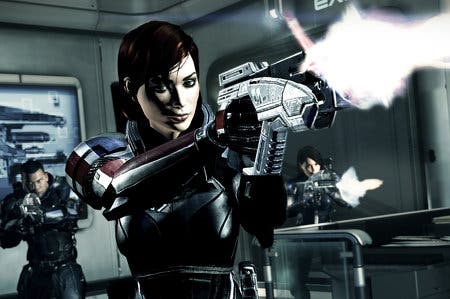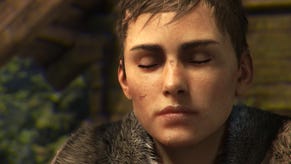Face-Off: Mass Effect 3
Science fact.
| - | Xbox 360 | PlayStation 3 |
|---|---|---|
| Disc Size | 7.6GB (disc one), 7.0GB (disc two) | 14.03GB |
| Install | 7.6GB (disc one), 7.0GB (disc two) | - |
| Surround Support | Dolby Digital | Dolby Digital, DTS, 5.1LPCM |
The wait is over, and the final act in BioWare's acclaimed sci-fi saga has finally arrived to not just one platform, but all three, with a simultaneous release on PS3, 360 and PC being a series first. Since the original game's release five years ago on 360, the developer has gradually iterated on the underlying Unreal Engine 3 tech to suit each platform's architecture, with the recent PS3 demo casting doubts over whether their efforts there may have been a stretch too far.
Our early performance test established that this demo is indeed indicative of how the opening sequences run on Sony's platform in the full release. However, having played all three versions extensively since, it's fair to say that both console platforms are characterised by a unique set of advantages and disadvantages, which, based on your personal preference, can improve or detract from your experience with the game.
Image quality and performance have come a long way since the days of the first Mass Effect on Microsoft's console, where the game running straight from disc would have difficulties streaming, causing the frame rate to rest around the 20FPS mark and spur on some aggressive tearing. Mass Effect 2 dramatically improved on this and also incorporated new depth of field and bloom effects, plus sub-surface scattering which allowed for more advanced skin shaders on characters.
This middle entry also made its way to PS3 a year later, where it was running on the "enhanced" version of the engine (touted as the one being used as the basis for development of Mass Effect 3). This boasted some higher resolution textures, comparable performance to the 360, but also an overhauled lighting engine that, by comparison, looked simply different to the other versions rather than an outright improvement.
Unreal Engine 3: Updated Tech on All Formats
So how does the game look when placed side by side, given that each format is now using this same updated engine? Focusing on consoles first, we put image quality to the test in our head-to-head video using matching cut-scene footage, backed up by our massive Mass Effect 3 triple-format comparison gallery.
"From a visual perspective, all three versions are remarkably close with only shadow rendering showing any major differences across platforms."
It's remarkably close. The discreet motion blur on Shepard's movements has been reinstated on PS3 after its absence from the last game, and the method for rendering lighting is now clearly identical across both platforms. Texture and alpha resolutions are identical too; the most blatant differences we can pick out between the two are one-off glitches that pop up under close scrutiny in certain scenes. For example, reflection mapping on a marble floor when talking to the Illusive Man looks pared back on PS3, but during play is entirely as effective as other platforms.
However, one of the bigger recurring differences between the two home console formats is undoubtedly the way some shadows are rendered. Standard shadows cast from characters are again very closely matched, but it appears that the PS3 now also has indirect shadows enabled where the 360 does not. This is a feature available for selection on PC, and the results are quite similar for both good and bad reasons, depending on the nature of the lighting in the environment.
We do find that indirect shadows add an extra subtle extra layer of detail to character models placed around indoors settings in particular, where lighting diffuses more naturally to corners and curves on objects. However, when taken outside and combined with global illumination we begin to see the resulting shadow cascades produce some noticeable banding on surfaces which we'd rather do without. While an unflattering sight from certain angles, clearly BioWare sees its inclusion on PS3 as a step forward for the overall look of the game, and it's not responsible for any major hit to performance.

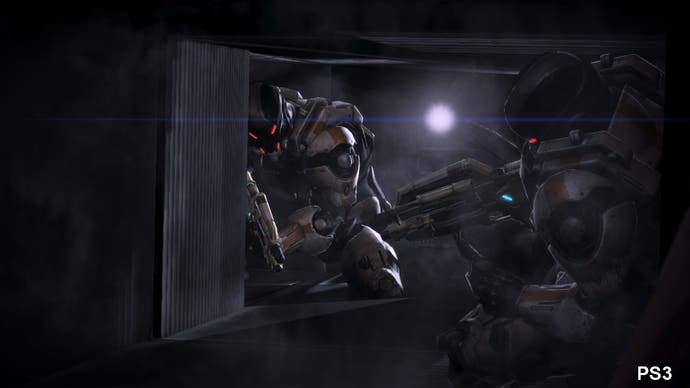
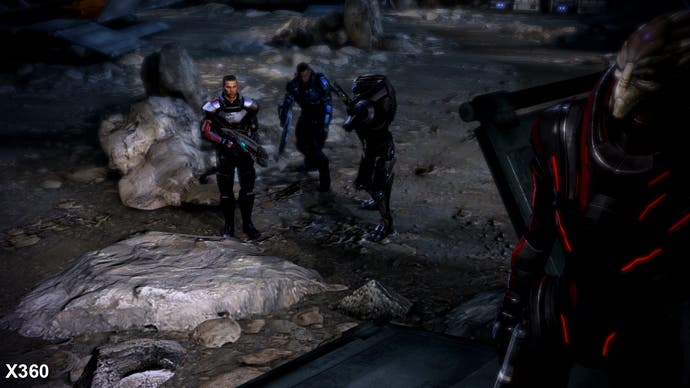
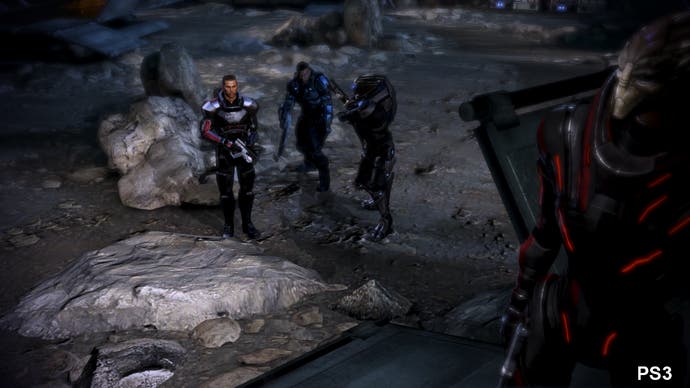
Speaking of image quality, it's to BioWare's credit that both versions run at the very same 1280x720 native resolution, and with a matching anti-aliasing method to boot. The conventional multi-sample approach used in Mass Effect 2 has been abandoned on the 360, where the PS3 had none at all, but here, both make very effective use of FXAA to clear up the sharp edges. In its implementation on PS3 we find that detail on distant texturing is blurred over just a smidgen more, however, suggesting the implementation is of lower quality.
"Both console versions of Mass Effect 3 appear to be using FXAA which works well with the visuals, commanding a minor visual advantage on 360."
The advantages in using this particular post-processing technique are tangible for a game like Mass Effect 3. Impressively, the processing time for its most recent version is just under 2ms for a full 1280x720 frame (though we suspect the older, faster implementation is used here) and the advantages are obvious: GPU time can be redirected from MSAA towards other effects.
Much like its application in Deus Ex Human Revolution, it also seems to pair quite nicely with games stylised with a futuristic, clinical aesthetic, where high density wall textures don't factor in as much. The algorithm FXAA uses takes the entire image and indiscriminately applies edge blurring to high-contrast lines, which can have the side effect of reducing definition to these detailed areas, but fortunately this doesn't appear to be too much of a detracting point in this case.
Otherwise, all effects and shaders seem incredibly well matched on both platforms - it's only the shadows and post processing which create the more noticeable variances between the two. It's also worthy of note that each console's overall disc sizes tally up to approximately 14GB, with the video data apparently being comprised of the same quality encodes for FMVs. It's a little bit of a shame that the PS3's Blu-ray capacity continues to go under-utilised in this regard, but the pre-rendered scenes don't tend to suffer from any noticeable artifacting, and are in fact quite difficult to differentiate between the actual in-engine cut-scenes when the big switches occur.
Console Performance Analysis
While it's impressive that Sony's platform is so closely matched with the 360 in visual terms - even going one further with its indirect shadowing - the frame rate on Sony's platform does suffer for it overall. We put performance to the test once again, this time sampling like-for-like cut-scenes and traversal sections from further into the game on both formats to see how they stand up to one another.
As with the previous game, each console sets 30FPS as its target refresh, with the 360 partially dropping v-sync when the engine is under load. We see subtle cases of tearing at the very the top of the screen as a result, often hidden by some HDTV's overscan areas, while the PS3 permanently engages v-sync to maintain image integrity.
"In some cases, performance is fine on both consoles, but on cut-scenes and some shooting scenarios it's clear that Xbox 360 offers the better experience."
The results are a mixed bag. Between the barren landscapes of Menae and the abandoned Prothean Archive complex, there's little to complain about when simply travelling from A to B during a mission. The frame-rate meets its target without any hassle, and similarly, performance is very consistent when walking around the Citadel or Normandy hub areas - which is just as well given that they're a regular fixture.
Cut-scenes are the killer though, and it's usually ones which drive the story forward that are more demanding. Here we see that little has changed from the opening segments of the game offered by the demo, where too many NPCs and alpha effects on screen can drag frame rates down on both platforms, with the PS3 even stabilising at the 15FPS mark for protracted spells during one cut-scene on Sur-Kesh. As a rule of thumb, the 360 doesn't have any problems at all in these scenarios, but in this case we see it go down to 20FPS with a few torn frames cropping up too.
Generally, these bouts of stuttering lessen in their frequency and severity by the game's middle act, and it's only the long passages of battle that can represent the real risk to playability. Mass Effect 3's third-person shooter mechanics have been further refined since the last game to bring it closer to the standard of genre-leaders like Gears of War, with hit detection that feels precise and sharp, and rewarding quick reactions from the controller. We take a look at how each console fares here by taking a slice of action-driven gameplay over several different missions.
Here we see that enemies using smoke grenades and dropships for backup has no impact on the 360, while these conditions force the PS3 to lock itself at 20FPS sometimes. In our experience this is a pretty regular occurrence, and controller response becomes an even larger issue during boss fights where fluctuations tend to be wilder. By comparison, the 360 offers greater consistency in performance across the board, but the PS3 does step up its game a after a poor showing early on.
Disc-Swapping and Kinect Utilisation
Interestingly, the PS3 has a distinct advantage over the 360 when it comes to convenience of use, mainly relating to the larger capacity of its Blu-ray format. The 360 version is spread across two DVDs, with the main "Priority" quests on the first, and side missions on the second. The decision to divide the game up this way is an odd one, and will likely be an inconvenience to players who intend to regularly switch between BioWare's main course and its 50-plus side portions. Given that many of these extra missions are accessible at any time during the game, it's hard to picture an alternative way to slice the content that would still keep the game's basic structure intact. Unlike other multi-disc RPGs for the format, such as Lost Odyssey or Blue Dragon, the quests aren't being dealt out in a linear sequence.
"The 360 version concentrates story missions on one disc and side quests on the other, resulting in a fair amount of disc-swapping, depending on how you play the game."
Those looking to play the game without any interruptions may take kindly to the single-disc solution on PS3, where you can quickly dart between any mission type seamlessly. The PS3 also has the added bonus of requiring no mandatory install, unlike the last game in the series, although the constant streaming from disc does incur some longer loading times.
Meanwhile, Microsoft has been pushing for developers of all disciplines to support their new motion sensing add-on, Kinect, and in BioWare it has found an unlikely adopter - for some aspects of the hardware at least. Support of the device allows you to voice basic commands to AI allies during battle, such as pressing forward to the next cover area or using a character-specific ability, while also letting you spell out the options on dialogue wheels. This is an intriguing change of pace from the proliferation of dance, party and children's titles that currently comprise Kinect's library, and is certainly a welcome attempt at something a bit different, but you do have to wonder why the same thing couldn't have been achieved using the default headset mic used for Xbox Live gameplay.
The PC Situation
Turning our attention to the PC version, we're satisfied that it's the version to get due to its support of higher resolutions, but perhaps a little underwhelmed with the game's sparing selection of graphical settings. Here's how it stacks up visually to the 360 version in 720p, with a PS3/PC mirror of the video also available to stream.
Besides toggles for FXAA, indirect shadows, and resolution to toy with via the in-game graphics tab, you're otherwise left to your own devices if you're looking to tweak the game's graphics at any advanced level. There is a "GamesSettings" ini file available which allows you to alter effects within the lighting and shadowing systems, such as dynamic shadows, cinematic light passes on characters and spherical harmonic lighting, where removing the latter results in a slightly more clinical looking image overall. Tweaking the dynamic shadows shadows also gives those on a lower specification hardware some wiggle room as far as performance is concerned.
There are also options for setting your anisotropic filtering of choice, plus a boolean line for deciding whether motion blur should be available. Ideally, these parameters should be put at the forefront of the game's menus, but this still comes across as a pretty slim selection of options by PC standards; for the undiscerning gamer though, the core game and its assets are impeccably translated here and immediately set for optimised play right after installation.
"Running at 1080p offers obvious additional clarity, but it is not matched by increases in texture quality, which is a let-down."
It's fortunate that the game looks as great as it does without any extensive meddling with graphical presets necessary, but we'd imagine it will leave some users wanting. If you'd rather avoid the slight blur incurred by the built-in FXAA, it becomes necessary to boot up your GPU's control panel to add your own multi-sample AA. The lack of any option to unlock higher levels of texture detail can also be quite glaring at times, where playing at 1080p brings the blocky patterning on character clothing to the fore in pretty spectacular fashion. Improvements to texture filtering are present too, particularly recognisable on long stretches of groundwork.
In our experience, the bespoke setting for indirect shadows makes for a rather minimal difference on the constitution of most scenes. At its best it's subtle, while in other appearances you'll see the same gradient banding effect on long surfaces evident in its PS3 implementation.
The one-size-fits all mentality for options has its benefits though, particularly as far as accessibility is concerned. When considering performance, limiting these variables no doubt makes optimisations for a range of potential rig setups much easier, while its UE3 foundation also allows it to scale well to most hardware setups. For our test rig, sporting an Intel Core 2 Q6600 processor clocked at the stock 2.4GHz, 4GB of DDR2 RAM and an AMD Radeon HD 6870, we find the frame rate while running at 1080p holds out at 50FPS and above in most situations (with the chaotic introductory scenes being an outlier).

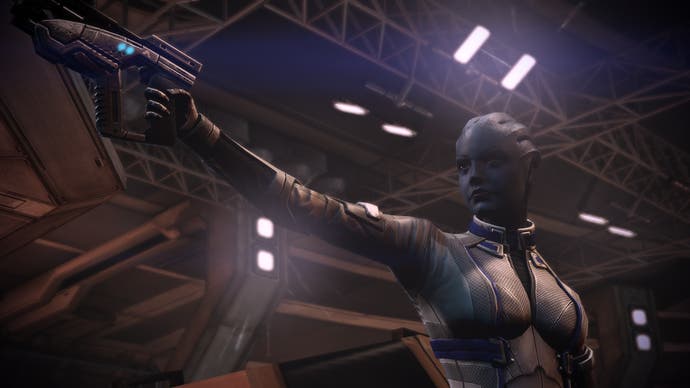

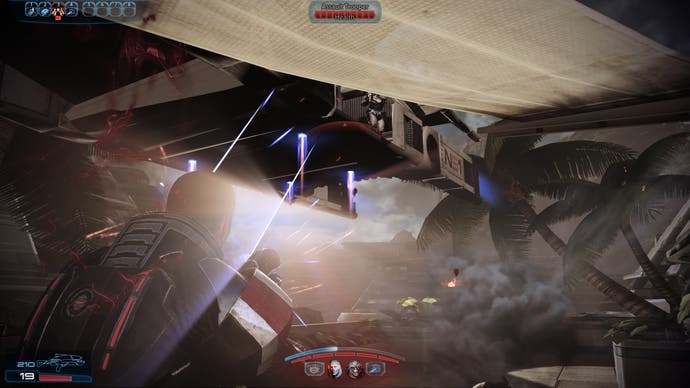
Speaking of controls, BioWare's experience in UI design for PC certainly shows here. As with previous entries in the series, the entire hot-key system is much faster to navigate than the abilities wheel approach utilised on consoles, with the difficulty being ramped up accordingly to compensate for this relative ease of use. Sadly, there's currently no announced intention to include 360 gamepad support as an alternative for those that might want it, which we feel is a missed opportunity given that much of the UI work is already complete on other platforms. Nevertheless, there's little to complain about with what's being offered.
Overall, the PC release is nigh-on identical to what's available on console, outside of improvements to texture filtering, its revised control system and the ability to power past the frame-rate limitations. Put side-by-side at 720p, it's difficult to tell the differences at times: the bloom, lighting, shadows, and particle effects all manifest to the same level of quality during play, regardless of which platform you're running on. Certainly impressive from the console side, but we'd argue that a PC release should be a little more ambitious.
Mass Effect 3: The Digital Foundry Verdict
"Xbox 360 offers higher performance on console while PS3 cuts out the disc-swapping, but it's clearly the PC game that offers the best overall experience."
So draws to a close the plot arc of Commander Shepard, where over 1000 variables across each game will have sculpted the backdrop to your narrative. But which version wins out? Simply put, the PC is home to the best-in-class carrier Mass Effect experience, being a well-optimised slice of the very same game with near-identical assets and a more flexible user interface for combat. The only caveat here is the meagre selection of graphics settings.
However, if you're keen to play the game with a controller in hand, the 360 version is undoubtedly the next in line. Between the console versions, it tends to be far more consistent in meeting its target 30FPS during cut-scenes and heavy combat, accepting that it will discreetly tear at the top 10 per cent of the screen during those peak moments of action. This is a notable lead on the PS3's rigidly v-synced performance which, while better optimised during Priority missions in the game's second act, is still prone to locking at 20FPS during cut-scenes and combat scenarios with multiple characters in view.
The only real disappointment with the 360 version is Bioware's decision to slice its content across two DVDs, awkwardly forcing a divide between the main story and the side-missions. For a completist, this will doubtless result in multiple disc-swaps between its 50-plus missions. Meanwhile, the PS3 version naturally sidesteps the issue altogether by brute force of the Blu-ray disc's higher capacity, allowing you to dive into the optional content seamlessly from the main quest.
Putting the console versions side-by-side, then, calls into question your preference for levels of performance and your tolerance for disc-swapping. This apples and oranges situation makes a final call less clear-cut, but if you're a newcomer to the series looking to jump straight in and play through the main story, then the much smoother performance on the 360 makes that version an easy recommendation. However, if you're a long-term Mass Effect fan who's mostly captivated by its RPG trappings, then these technical gripes become subaltern, and the recommendation should instead lay with the console on which you've invested more time distinguishing your character.
